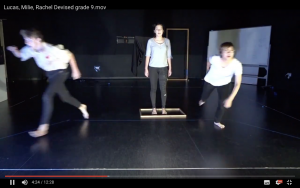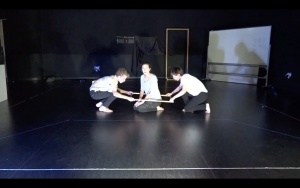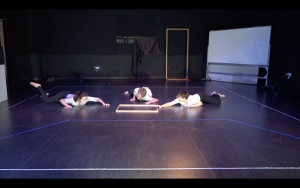Describe the dramatic moment that seemed to make the most impact on the audience in your devised piece, and say why you think this was. Explain the dramatic choices that your group made to heighten this moment.
One dramatic moment in our performance was when my character is standing alone on stage, while Lucas and Rachel are in the audience, whispering, asking for help. While this is happening, I say “It’s funny that. You can be surrounded by people, and yet still feel so alone.” This scene highlights  the loneliness that you feel when traveling alone; as most asylum seekers are; even when there are people all around. All of the dramatic choices that we made were to heighten this feeling. For example, our choice to have Rachel and Lucas join the audience to break the fourth wall allowed the audience to relate to what I was saying even further – they were literally surrounded by people – while I was alone on stage, representing the feeling of loneliness. So the audience is surrounded by people but can see the loneliness. Another example was how we chose to have Lucas and Rachel whispering frantically, in contrast to my loud and clear words. This helped the audience understand the meaning a bit more. We also chose to have a spotlight on me so I stood out – again, emphasizing the feeling of loneliness. And our final choice was how we chose to stop the music. This meant that all the focus was on me, and the moment was even more dramatic. This moment had a big impact on the audience because for the first time, they could relate to what the asylum seekers were going through. Everyone has felt alone before, not even necessarily while traveling, but everybody can relate to that feeling of loneliness when there are people all around.
the loneliness that you feel when traveling alone; as most asylum seekers are; even when there are people all around. All of the dramatic choices that we made were to heighten this feeling. For example, our choice to have Rachel and Lucas join the audience to break the fourth wall allowed the audience to relate to what I was saying even further – they were literally surrounded by people – while I was alone on stage, representing the feeling of loneliness. So the audience is surrounded by people but can see the loneliness. Another example was how we chose to have Lucas and Rachel whispering frantically, in contrast to my loud and clear words. This helped the audience understand the meaning a bit more. We also chose to have a spotlight on me so I stood out – again, emphasizing the feeling of loneliness. And our final choice was how we chose to stop the music. This meant that all the focus was on me, and the moment was even more dramatic. This moment had a big impact on the audience because for the first time, they could relate to what the asylum seekers were going through. Everyone has felt alone before, not even necessarily while traveling, but everybody can relate to that feeling of loneliness when there are people all around.
How did your group manage scene changes or transitions from one section to another in your devised piece? How effective were these scene changes or transitions? How could you have improved them to make them more effective?
The frame helped our transitions. Our performance wasn’t in chronological order, so we had to be clear when it was a flashback and when it wasn’t, by repeating the transition. We used the frame as a ‘photograph’ we were confined to in our flashbacks. In the beginning, when doing our mundane  activities and saying “what a lovely day”, we’re confined to the frame. We show what life used to be like before the war, and although the audience doesn’t know what the frame represents yet, we start using it right from the beginning to minimise – and hopefully avoid – confusion. Later on, when I tell Lucas about my journey, I stay inside the frame – because my memories are limited. The ‘photograph’ only shows so much. The frame was perfect for representing this. Further on, when Rachel is narrating and telling us about herself, she is holding the frame/photograph and peering through it, as if she’s describing the photo. Repetition of the frame transition made it clear what was happening, and it was effective in how it communicated the events. Perhaps it would have been more effective if we’d established what it represented earlier.
activities and saying “what a lovely day”, we’re confined to the frame. We show what life used to be like before the war, and although the audience doesn’t know what the frame represents yet, we start using it right from the beginning to minimise – and hopefully avoid – confusion. Later on, when I tell Lucas about my journey, I stay inside the frame – because my memories are limited. The ‘photograph’ only shows so much. The frame was perfect for representing this. Further on, when Rachel is narrating and telling us about herself, she is holding the frame/photograph and peering through it, as if she’s describing the photo. Repetition of the frame transition made it clear what was happening, and it was effective in how it communicated the events. Perhaps it would have been more effective if we’d established what it represented earlier.
Another transition we used was the drowning motif, which we repeated, showing the story development. After every third scene, we would repeat the drowning motif, but with a tiny tweak: it would be a different person who was drowning. We repeated the shipwreck scene afterwards to remind the audience it was in present time. The repetition of this motif made the piece very concise; it gave a nice storyline and allowed us to play with the non-chronological order without being confusing. We deliberately modified it slightly each time – a different person, a different length. After searching and reliving the drowning (motif) three times, we finally see land – and the final modification is what brings our piece to a conclusion. Because of the tweaks, I don’t think it was boring, but it may have been repetitive and perhaps we could have done bigger modifications to keep the audience engaged and to be more effective.
As you worked on your devised piece, what contrasts did you create? How effective were these contrasts?
In the storm scene, we contrast use of atmosphere by to convey our emotions. Most of this contrast was shown through movement and facial expressions, but also largely through space, levels and pace. For example; the most basic way we showed contrast was how we convulsed grotesquely, fighting for the frame, but as soon as Lucas touches it, we freeze. The contrast between fast movements and no movement shows the helplessness that we felt; that frame is what’s keeping us alive; without it we have no hope. Our facial expressions also showed this. When twisting, our facial expressions were crazed and desperate, whereas when frozen, we looked defeated and resigned to dying. 
The space and blocking was simple: me and Rachel on either side of Lucas, writhing. Those grasping for the frame were on the floor, but when the frame was placed over our heads, we were ‘saved’. We stood up and were much more neutral. The pace also slows a lot when we’re ‘saved’. This contrast highlights the desperation that you feel when struggling to survive.
With a non-chronological timeline, our performance had a lot of contrast of location. One example was our daily chores, (confined to the frame), and chorally saying the line “what a lovely day,”. This scene had us all repeating an action – washing the clothes, scrubbing, and cooking – to show monotonous, limited, daily life. This scene is immediately followed by destruction of the city: horrible twisting and shuddering, which is very different to the slower paced, dull movements we had done just prior. In these scenes, we showed contrast of pace, movement and space. The purpose of  this contrast in location is to show the difference between domestic life and wartime living. Another point of location contrast were the numerous times we had the drowning motif, followed by the shipwreck, where there was a lighting change and change in space and pace. In the motif, there is a lot of tension, partly because of the pace, which is dissolved when we transition to the shipwreck scene. However, each time we repeat it, the tension increases. The purpose of this contrast in loca]tion is to build tension and show that you can survive experiences that you don’t think you can.
this contrast in location is to show the difference between domestic life and wartime living. Another point of location contrast were the numerous times we had the drowning motif, followed by the shipwreck, where there was a lighting change and change in space and pace. In the motif, there is a lot of tension, partly because of the pace, which is dissolved when we transition to the shipwreck scene. However, each time we repeat it, the tension increases. The purpose of this contrast in loca]tion is to build tension and show that you can survive experiences that you don’t think you can.
Here is my Devised piece video.